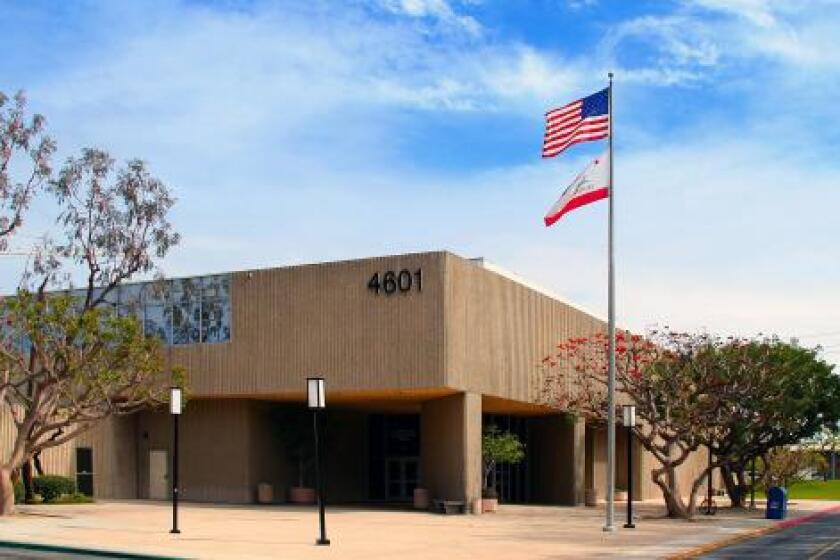COMMENTS & CURIOSITIES:
- Share via
Ever had triplets? I haven’t.
Dania Reid has though — three healthy, fully charged, no-assembly-required boy babies named Kaine, Hunter and Raedin, born July 5 at Hoag Hospital.
The newly minted Reid boys are members of a very exclusive club — identical multiple births, all-natural, born without fertility treatments, thank you very much.
How exclusive is that club? You have roughly the same odds of finding a space in that little lot between Neiman’s and Bloomingdale’s as you do of finding identical triplets born without fertility treatments, which is about one in a million, according to Hoag’s Dr. Tomerou Asrat.
Compare that to the odds of having fraternal twins — about one in a hundred. For those of you who were always cutting biology, identical twins come from a single fertilized egg that splits into separate embryos, while fraternal twins come from separate eggs that were fertilized at the same time, but have no biological connection other being born at the same time when the time comes, which explains why fraternal twins often look nothing like each other.
At first, the Reids thought they would be having a baby, as in one, then learned with each doctor’s visit that it looked like twins, and a few weeks later, triplets. At that point, I would have asked the doctor to stop counting.
I imagine it did. But all that matters now is that the entire crew is fine. The story caught my eye for two reasons — one, identical multiples really are rare; and two, I come from a long line of obstetricians, including my father and my brother.
I have two sets of clippings of my father in New York newspapers with triplets that he delivered on two occasions, although I don’t know whether either was identical. He delivered a total of three sets of triplets, and this was years before fertility treatments. He and my brother delivered enough twins to clean out at least four Baby Gaps.
But that was then, this is now — so let’s get to the good stuff.
The first quadruplets to make it to adulthood in this country were the Keys Quads of Hollis, Oklahoma. On June 4, 1915, Alma Keys had her babies at home.
The girls were all named for friends of Alma’s who were there helping Dr. William Pendergraft with his hectic house call. The doc only had one birth certificate with him, which seemed more than enough before all those heads started to appear. He listed all four girls on the “name” line and put “all girls” on the gender line.
While it seems bizarre if not flat-out wrong today, in those less enlightened times, multiple birth siblings were put on display for all to see. From the age of 9 months until they were young women, the Keys Quads appeared at state and county fairs as a special “exhibit.” According to Roberta, people recognized them throughout their lives and sometimes would tell them they paid a dime or a quarter to see them as kids.
“Well,” Roberta would answer, “…do you want your money back?”
The most famous multiple birth siblings by far were the Dionne quintuplets — Annette, Cecile, Emilie, Marie and Yvonne — identical quints who were born in a remote farmhouse in northern Canada on May 28, 1934.
The treatment the Dionne Quints received was even worse than the Keys Quads, although the intentions were better, sort of. Convinced that the girls’ dirt-poor parents, especially their reportedly abusive father, would be unable to provide for them, the Canadian government declared them wards of the state and built a hospital near their home for no other reason but to care for the quints.
In an even more bizarre twist, the doctor who delivered them, Dr. Allan Roy Dafoe, was granted sole custody of the quints and spent years caring for and raising them at their single-purpose “hospital,” which was called Dafoe Hospital but nicknamed “Quintland.”
Between 1934 and 1943, about 3 million tourists from around the world made the trek to Quintland to see the girls. There were viewing areas where drapes of gauze separated the gawkers from the girls, who supposedly were unaware they were being watched.
Years later, a reporter asked Yvonne if that was true. “Of course not,” she said, “…we saw their shadows and could hear them moving and talking.” The Dionne quints became a global enterprise, with their images and endorsement on products of every description in scores of countries — all managed by Dafoe, whose entire practice now consisted of five small “patients.” Apparently, “the good old days” is a relative term.
And there you have it, more or less. If you happen to run into the Reid boys, wish them well and don’t make any dumb remarks about how much they look like each other. They didn’t plan it that way. It just happens, now and then, every millionth time or so.
I gotta go.
PETER BUFFA is a former Costa Mesa mayor. His column runs Sundays. He may be reached at [email protected].
All the latest on Orange County from Orange County.
Get our free TimesOC newsletter.
You may occasionally receive promotional content from the Daily Pilot.



